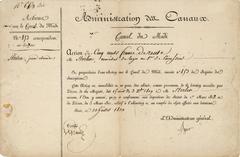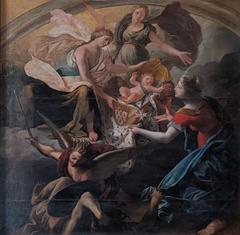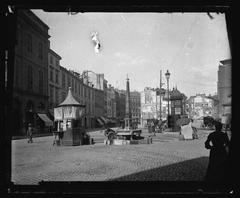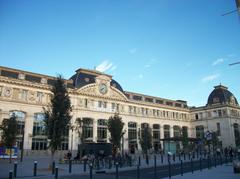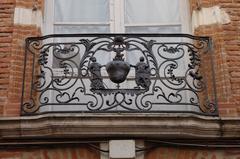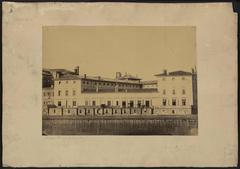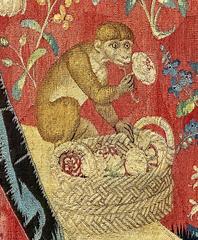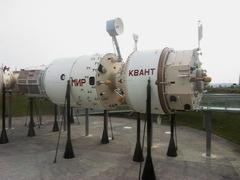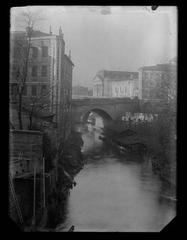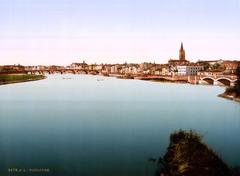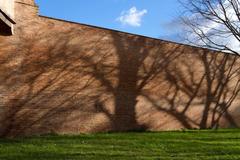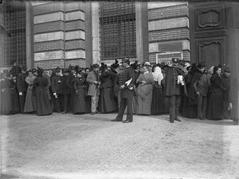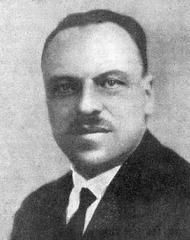Empalot Toulouse Historical Site: Visiting Hours, Tickets, and Travel Guide
Date: 04/07/2025
Introduction: Discovering Empalot’s Unique Place in Toulouse
Empalot, located in the southern part of Toulouse, is a neighborhood that intricately weaves together layers of history, dynamic culture, and ambitious urban renewal. Its story spans from prehistoric settlements through Roman commerce, medieval decline, industrialization, and 20th-century social housing, to its current role as a vibrant, multicultural district undergoing transformative development. For visitors eager to explore beyond Toulouse’s celebrated landmarks, Empalot offers a compelling look at the city’s evolving identity—where ancient heritage meets contemporary urban life (Wikipedia).
This guide provides a comprehensive overview of Empalot’s historical milestones, cultural significance, practical visiting details, and insider tips to help you make the most of your experience in this fascinating district. For real-time updates and immersive experiences, consider downloading the Audiala app and following Toulouse’s cultural channels.
Table of Contents
- Empalot’s Historical Timeline
- Empalot Today: Culture, Community, and Urban Renewal
- Visitor Information: Hours, Tickets, and Accessibility
- Key Sites and Attractions in Empalot
- Nearby Toulouse Landmarks
- Frequently Asked Questions (FAQ)
- Summary: Why Visit Empalot?
- References and Official Sources
Empalot’s Historical Timeline
Prehistory and Antiquity
Empalot’s roots stretch deep into the Neolithic era, with archaeological excavations uncovering evidence of human habitation as early as 5000 BCE. Its strategic position along the Garonne River and, later, a major Roman road (now Rue Achille Viadieu), made it a key point of trade and settlement during antiquity. Amphorae fragments found here highlight the neighborhood’s role as a commercial hub connected to the broader Roman world (Wikipedia).
Medieval Marginalization
With the expansion of Toulouse from the 1st century CE, Empalot’s prominence waned. The area became increasingly marginalized, notably with the creation of a refuse dump (“pailhas”) in the Daste sector. While Toulouse thrived on textile and pastel-dyed cloth production, Empalot remained peripheral and insalubrious (OverYourPlace).
Name Origins and 19th-Century Growth
The name “Empalot” derives from Jean Palot, who sold his lands to the Chapter of Saint-Étienne in 1443. The construction of the Empalot Bridge in 1860 linked the area to the Île du Ramier and helped establish its modern identity. Despite Toulouse’s industrial expansion in the 19th and early 20th centuries, Empalot remained a largely residential, working-class district (Wikipedia).
Post-War Urbanization
In the 1950s, Empalot underwent significant change with the development of social housing complexes (notably the Cité Daste) to address post-war population growth and housing shortages. This mirrored broader trends in French urban planning, resulting in dense rows of apartment blocks and a diverse, multicultural population (ANRU).
Decline and Stigma in the Late 20th Century
By the late 20th century, Empalot suffered from underinvestment, unemployment, and social exclusion, earning a reputation as a “quartier sensible” (sensitive neighborhood). The 2001 explosion at the nearby AZF chemical plant further strained the area’s social fabric (Sacavoyage).
21st-Century Renewal
Starting in the early 2000s, the arrival of the metro and major urban renewal projects began to reverse Empalot’s fortunes. Large-scale demolition and reconstruction efforts, the creation of new green spaces like Jardin de Daste, and the opening of the Empalot pedestrian bridge are reshaping the neighborhood into a more inclusive and sustainable community (Actu.fr, ToulouseImmo9).
Empalot Today: Culture, Community, and Urban Renewal
Empalot’s identity today is defined by its cultural diversity, community resilience, and the ongoing reimagining of its urban landscape.
- Multicultural Vibrancy: Home to residents with North African, Sub-Saharan, Portuguese, and French backgrounds, Empalot showcases Toulouse’s cosmopolitan spirit (Toulouse Tourisme).
- Artistic Expression: Colorful street art and murals narrate stories of migration, identity, and hope, with community-driven festivals and cultural events held throughout the year.
- Strong Community Life: Local associations offer language classes, art workshops, music lessons, and neighborhood festivals like the Fête de Quartier d’Empalot, fostering inclusion and celebration (France.fr).
- Religious and Educational Diversity: Mosques, churches, and secular centers coexist, and schools collaborate with artists for inclusive education. The neighborhood library provides multilingual resources and cultural programming.
- Gastronomy: Empalot’s market and eateries reflect its multicultural heritage, with French, North African, and Portuguese foods among the offerings (FrancePocketGuide).
- Sports and Leisure: Facilities like Stade d’Empalot and local parks support football, pétanque, and fitness, promoting social integration.
- Ongoing Urban Renewal: Residents are engaged in the planning process for new housing, public spaces, and infrastructure, ensuring Empalot retains its unique character while evolving (ANRU).
Visitor Information
Visiting Hours:
Empalot’s parks and public spaces are open year-round, generally from dawn to dusk. The Centre Culturel Henri Desbals is open Monday to Friday, 9:00 AM–7:00 PM.
Tickets and Entry:
No tickets are needed to explore Empalot or its public sites. Some cultural events or workshops may require registration or a small fee.
Accessibility:
Empalot is accessible by Metro Line B (Empalot station), multiple bus lines, and cycling paths. Most public spaces and renovated facilities are wheelchair-friendly.
Travel Tips:
- Explore the Jardin de Daste and Garonne riverbank for scenic walks and photography.
- Local markets (Wednesday and Saturday mornings) offer a taste of the neighborhood’s multicultural flair.
- For dining, try both local bakeries and international food stalls.
Key Sites and Attractions
Centre Culturel Henri Desbals
A pivotal community hub for cultural events, Occitan heritage programming, and workshops. Entry is free; check the official schedule for special activities.
Les Jardins d’Empalot
Open-access community gardens and parks ideal for relaxation and social gatherings.
Empalot Market
Operating Wednesday and Saturday mornings, this market is renowned for its fresh produce and international specialties.
Empalot Pedestrian Bridge
A striking new link to Île du Ramier—Toulouse’s future “Central Park”—offering panoramic views of the Garonne River (ToulouseImmo9).
Street Art and Architecture
Stroll Empalot’s streets to discover vibrant murals and observe the contrast between post-war housing blocks and cutting-edge eco-friendly developments.
Nearby Toulouse Landmarks
Empalot is a short metro ride from Toulouse’s historic center, making it an ideal base for exploring:
- Basilica of Saint-Sernin: A UNESCO World Heritage Site and one of Europe’s largest Romanesque churches. Open daily 9:00 AM–6:00 PM; entry is free, guided tours available (Official Basilica Website).
- Place du Capitole: The city’s iconic central square (Taste of Toulouse).
- Les Abattoirs Museum of Modern Art: Exhibitions on urbanism and social change (Espace Toulouse).
- Cité de l’Espace: Space-themed park and museum for families and science enthusiasts (Thousand Hotels).
- Canal du Midi: Unesco-listed walking and cycling route north of Empalot.
Frequently Asked Questions (FAQ)
Q: Are there entrance fees for Empalot’s sites?
A: No, Empalot’s parks, markets, and cultural centers are free to visit. Some events may require tickets.
Q: How do I get to Empalot?
A: Take Metro Line B to Empalot station. Several bus routes and bike paths also serve the area.
Q: Is Empalot safe for tourists?
A: Empalot is increasingly welcoming and safe, though usual urban precautions are recommended.
Q: Are guided tours available?
A: Occasionally, guided tours focusing on history and architecture are offered by the Centre Culturel Henri Desbals.
Q: When is the best time to visit?
A: Spring and early autumn offer the best weather; festivals and street art events provide especially rich experiences.
Summary: Why Visit Empalot?
Empalot exemplifies Toulouse’s ability to balance ancient heritage with modern transformation. Its history spans Neolithic settlements, Roman trade, and industrialization, and its present is marked by cultural vitality, inclusiveness, and forward-thinking urban renewal. With easy access to both local attractions and major city landmarks, Empalot is the ideal destination for those seeking a genuine, multifaceted Toulouse experience (Wikipedia, ANRU, Toulouse Tourisme).
Download the Audiala app for audio-guided tours, and follow us on social media for the latest on Empalot and Toulouse’s cultural scene.
References and Official Sources
- This is a sample text. (Wikipedia)
- This is a sample text. (ANRU)
- This is a sample text. (OverYourPlace)
- This is a sample text. (Sacavoyage)
- This is a sample text. (Actu.fr)
- This is a sample text. (Actu.fr)
- This is a sample text. (ToulouseImmo9)
- This is a sample text. (Toulouse Tourisme)
- This is a sample text. (France Bleu)
- This is a sample text. (Official Basilica Website)
- This is a sample text. (Taste of Toulouse)
- This is a sample text. (Espace Toulouse)
- This is a sample text. (Thousand Hotels)
- This is a sample text. (France.fr)
- This is a sample text. (FrancePocketGuide)
- This is a sample text. (Travel Vagabonds)
- This is a sample text. (JJ Bucket List Travellers)
- This is a sample text. (Audiala App)

